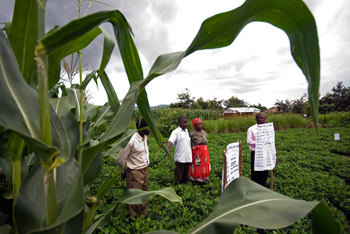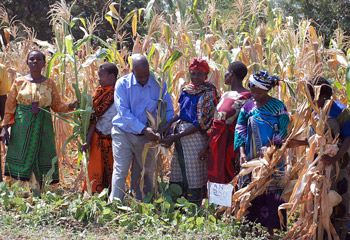Gender strategy
The objective of the MAIZE gender strategy is:
To promote equality of opportunity and outcomes between resource-poor women and men farmers in maize-based systems.
Gender equality and equity are essential elements in the quest to further enhance agricultural growth, food security and sustainable use of the natural resource base. The MAIZE CRP Gender Strategy represents a concerted effort of the maize R4D community to systematically consider and address gender disparities in maize R4D and contribute to the promotion of gender equality in agricultural development in general.
Click to download the MAIZE CRP Gender Strategy.
Integrating gender into WHEAT and MAIZE CRPs
The 16 CGIAR Research Programs (CRPs) are developing strategies to integrate gender into research. In September 2012, CIMMYT commissioned the Social Development and Gender Equity team of the Royal Tropical Institute (KIT) in Amsterdam to carry out a gender audit of the CGIAR Research Programs (CRPs) on WHEAT and MAIZE.
The objective of the assignment was “to provide a solid analytical and operational input to the process of strengthening institutional capacity to integrate gender as an analytical tool for enhanced targeting and impact of research for development under MAIZE and WHEAT; and to devise realistic and practical Gender Action Plans for MAIZE and WHEAT.”
Among the first CRPs to undertake a gender audit of their activities, WHEAT and MAIZE organized a workshop on implementing the gender audits on 10-11 December 2012, facilitated by gender specialists Chris Hunter and Katrine Danielsen, both from KIT.
How is a gender audit conducted?
 A gender audit is an assessment by which organizations can identify how they are addressing gender within their research programs and organization. It usually comprises surveys and focus group discussions involving organizations, partners and those who are ‘watching what the organization does.’ For MAIZE and WHEAT, it should provide a baseline for assessing progress on integrating gender into the CRPs and help prioritize activities.
A gender audit is an assessment by which organizations can identify how they are addressing gender within their research programs and organization. It usually comprises surveys and focus group discussions involving organizations, partners and those who are ‘watching what the organization does.’ For MAIZE and WHEAT, it should provide a baseline for assessing progress on integrating gender into the CRPs and help prioritize activities.
The gender audit is being implemented in a phased approach. The initial collaborative Design Phase ran from September to December 2012, the Implementation Phase ran from January to September 2013 and the Participatory Analysis Phase took place in October 2013.
The Gender Audit focuses on four key questions and eight CIMMYT projects. This will lead to a detailed gender action plan.
Gender Audit questions:
|
Early findings
 The rationales for integrating gender range from:
The rationales for integrating gender range from:
- Fulfilling donor requirements
- Increasing CRP impact
- Promoting equal rights and benefits of women and men
- The perception of women farmers’ roles is often stereo-typed, and they are not seen as active agents in diverse dimensions
- Objections to gender exist in relation to up-stream research, and there is often limited awareness
- There is a need to deepen the understanding and the commitment to the integration of gender across the CRPs
Download the 2014 Gender Audit Summary Report
Further reading:
- The Gender in Agriculture Sourcebook, (World Bank, FAO, IFAD), 2009
- The state of food and agriculture 2010-2011 (FAO), Women in agriculture: closing the gender gap for development
- CGIAR Gender and Agriculture Research Network, Addressing the gender gap in agriculture: opportunities for collaboration in gender-responsive research, 2012
